Introduction
Contents
List of figures
List of tables
Editorial Notes
3. Definitions, acronyms, and abbreviations
3.2 Definitions specific to IEEE 802.11
3.4 Abbreviations and acronyms
4. General description
4.3 Components of the IEEE Std 802.11 architecture
4.3.14a High efficiency (HE) STA
6. Layer management
6.1 Overview of management model
6.2 Generic management primitives
6.3 MLME SAP interface
6.3.3 Scan
6.3.3.3 MLME-SCAN.confirm
6.3.3.3.2 Semantics of the service primitive
6.3.4 Synchronization
6.3.4.2 MLME-JOIN.request
6.3.4.2.2 Semantics of the service primitive
6.3.7 Associate
6.3.7.4 MLME-ASSOCIATE.indication
6.3.7.4.2 Semantics of the service primitive
6.3.8 Reassociate
6.3.8.4 MLME-REASSOCIATE.indication
6.3.8.4.2 Semantics of the service primitive
6.3.11 Start
6.3.11.2 MLME-START.request
6.3.11.2.2 Semantics of the service primitive
6.3.27 Management of direct links
6.3.27.4 6.3.27.4 MLME-DLS.indication
6.3.27.4.2 6.3.27.4.2 Semantics of the service primitive
8. PHY service specification
8.3 Detailed PHY service specifications
8.3.5 PHY SAP detailed service specification
8.3.5.2 PHY-DATA.request
8.3.5.2.2 Semantics of the service primitive
8.3.5.3 PHY-DATA.indication
8.3.5.3.2 Semantics of the service primitive
8.3.5.10 PHY-CCARESET.request
8.3.5.10.3 When generated
8.3.5.12 PHY-CCA.indication
8.3.5.12.2 Semantics of the service primitive
8.3.5.12.3 When generated
9. Frame formats
9.2 MAC frame formats
9.2.4 Frame fields
9.2.4.1 Frame Control field
9.2.4.1.3 Type and Subtype subfields
9.2.4.1.8 More Data subfield
9.2.4.1.10 +HTC/Order subfield
9.2.4.5 QoS Control field
9.2.4.5.4 Ack Policy subfield
9.2.4.5.6 Queue Size subfield
9.2.4.6 HT Control field
9.2.4.6.1 General
9.2.4.6.3 VHT variant
9.2.4.6.4 A-Control
9.2.4.6.4.1 General
9.2.4.6.4.2 UL MU response scheduling
9.2.4.6.4.3 Operating Mode
9.2.4.6.4.4 HE link adaptation
9.2.4.6.4.5 Buffer Status Report (BSR)
9.2.4.6.4.6 UL power headroom
9.2.4.6.4.7 Bandwidth Query Report (BQR)
9.2.4.6.4.8 Reverse direction protocol (RDP)
9.2.4.7 Frame Body field
9.2.4.7.1 General
9.2.5 Duration/ID field (QoS STA)
9.2.5.2 Setting for single and multiple protection under enhanced distributed channel access (EDCA)
9.2.5.7 Setting for control response frames
9.3 Format of individual frame types
9.3.1 Control frames
9.3.1.2 RTS frame format
9.3.1.3 CTS frame format
9.3.1.5 PS-Poll frame format
9.3.1.6 CF-End frame format
9.3.1.8 BlockAckReq frame format
9.3.1.8.1 Overview
9.3.1.8.2 Basic BlockAckReq variant
9.3.1.9 BlockAck frame format
9.3.1.9.1 Overview
9.3.1.9.3 Compressed BlockAck variant
9.3.1.9.7 Multi-STA BlockAck variant
9.3.1.20 VHT/HE NDP Announcement frame format
9.3.1.23 Trigger frame format
9.3.1.23.1 Basic Trigger variant
9.3.1.23.2 Beamforming Report Poll variant
9.3.1.23.3 MU-BAR variant
9.3.1.23.4 MU-RTS variant
9.3.1.23.5 BSRP variant
9.3.1.23.6 GCR MU-BAR variant
9.3.1.23.7 Bandwidth Query Report Poll variant
9.3.2 Data frames
9.3.3 Management frames
9.3.3.1 Beacon frame format
9.3.3.5 Association Request frame format
9.3.3.6 Association Response frame format
9.3.3.7 Reassociation Request frame format
9.3.3.8 Reassociation Response frame format
9.3.3.10 Probe Request frame format
9.3.3.11 Probe Response frame format
9.4 Management and Extension frame body components
9.4.1 Fields that are not elements
9.4.1.11 Action field
9.4.1.62 HE MIMO Control field
9.4.1.63 HE Compressed Beamforming Report field
9.4.1.64 HE MU Exclusive Beamforming Report field
9.4.1.65 HE CQI-only Report field
9.4.2 Elements
9.4.2.1 General
9.4.2.3 Supported Rates and BSS Membership Selectors element
9.4.2.6 TIM element
9.4.2.27 Extended Capabilities element
9.4.2.139 ADDBA Extension element
9.4.2.200 TWT element
9.4.2.218 HE Capabilities element
9.4.2.218.1 General
9.4.2.218.2 HE MAC Capabilities Information field
9.4.2.218.3 HE PHY Capabilities Information field
9.4.2.218.4 Tx Rx HE MCS Support field
9.4.2.218.5 PPE Thresholds field
9.4.2.219 HE Operation element
9.4.2.220 OFDMA-based Random Access Parameter Set (RAPS) element
9.4.2.221 MU EDCA Parameter Set element
9.4.2.222 BSS Color Change Announcement element
9.4.2.223 Quiet Time Period Setup element
9.4.2.224 Quiet Time Period Request element
9.4.2.225 Quiet Time Period Response element
9.6 Action frame format details
9.6.4 DLS Action frame details
9.6.4.2 DLS Request frame format
9.6.4.3 DLS Response frame format
9.6.5 Block Ack Action frame details
9.6.5.1 General
9.6.8 Public Action details
9.6.8.16 TDLS Discovery Response frame format
9.6.8.36 FILS Discovery frame format
9.6.13 TDLS Action field formats
9.6.13.2 TDLS Setup Request Action field format
9.6.13.3 TDLS Setup Request Action field format
9.6.13.4 TDLS Setup Confirm Action field format
9.6.16 Self-protected Action frame details
9.6.16.2 Mesh Peering Open frame format
9.6.16.2.2 Mesh Peering Open frame details
9.6.16.3 Mesh Peering Confirm frame format
9.6.16.3.2 Mesh Peering Confirm frame details
9.6.28 HE Action frame details
9.6.28.1 HE Action field
9.6.28.2 HE Compressed Beamforming And CQI frame format
9.6.28.3 HE BSS Color Change Announcement frame format
9.6.29 Quiet Time Period Action frame details
9.6.29.1 Quiet Time Period Action field
9.6.29.2 Quiet Time Period Setup frame format
9.6.29.3 Quiet Time Period Request frame format
9.6.29.4 Quiet Time Period Response frame format
9.7 Aggregate MPDU (A-MPDU)
9.7.1 A-MPDU format
9.7.3 A-MPDU contents
10. MAC sublayer functional description
10.2 MAC architecture
10.2.4 Hybrid coordination function (HCF)
10.2.4.2 HCF contention based channel access (EDCA)
10.3 DCF
10.3.1 General
10.3.2 Procedures common to the DCF and EDCAF
10.3.2.1 CS mechanism
10.3.2.3 IFS
10.3.2.3.7 EIFS
10.3.2.4 Setting and resetting the NAV
10.3.2.4a Duration-based RTS/CTS
10.3.2.8a MU-RTS/CTS procedure
10.3.2.8a.1 General
10.3.2.8a.2 MU-RTS procedure
10.3.2.8a.3 CTS response to MU-RTS
10.3.2.10 MU acknowledgement procedure
10.3.2.10.1 Acknowledgement procedure for DL MU PPDU in SU format
10.3.2.10.2 Acknowledgement procedure for DL MU PPDU in MU format
10.3.2.10.3 Acknowledgement procedure for an UL MU transmission
10.3.5 Individually addressed MPDU transfer procedure
10.5 Fragmentation
10.7 Multirate support
10.7.1 Overview
10.7.6 Rate selection for Control frames
10.7.6.5 Rate selection for control response frames
10.7.6.5.2 Selection of a rate or MCS
10.7.9 Modulation classes
10.7.10 Non-HT basic rate calculation
10.9 HT Control field operation
10.10 Control Wrapper operation
10.12 A-MSDU operation
10.13 A-MPDU operation
10.13.1 A-MPDU contents
10.13.2 A-MPDU length limit rules
10.22 HCF
10.22.2 HCF contention based channel access (EDCA)
10.22.2.2 EDCA backoff procedure
10.22.2.4 Obtaining an EDCA TXOP
10.22.2.5 EDCA channel access in a VHT, HE or TVHT BSS
10.22.2.6 Sharing an EDCA TXOP
10.22.2.7 Multiple frame transmission in an EDCA TXOP
10.22.2.8 TXOP limits
10.22.2.9 Truncation of TXOP
10.22.4 Admission Control at the HC
10.22.4.2 Contention based admission control procedures
10.22.4.2.3 Procedure at non-AP STAs
10.24 Block acknowledgement (block ack)
10.24.10 GCR block ack
10.24.10.3 GCR block ack BlockAckReq and BlockAck frame exchanges
10.28 Reverse direction protocol
10.28.3 Rules for RD initiator
10.28.4 Rules for RD responder
10.43 Target wake time (TWT)
10.43.1 TWT overview
11. MLME
11.1 Synchronization
11.1.3 Maintaining synchronization
11.1.3.8 Multiple BSSID procedure
11.1.3.10 Beacon generation in an HE BSS
11.2 Power management
11.2.2 Power management in a non-DMG infrastructure network
11.2.2.6 AP operation during the CP
11.2.2.8 Receive operation for STAs in PS mode during the CP
11.2.2.17 TIM Broadcast
11.23 Tunneled direct-link setup
11.23.1 General
11.24 Wireless network management procedures
11.24.6 Fine timing measurement procedure
11.24.6.4 Measurement exchange
11.49 HE BSS operation
11.49.1 AID assign rule
17. Orthogonal frequency division multiplexing (OFDM) PHY specification
17.2 OFDM PHY specific service parameter list
17.2.2 TXVECTOR parameters
17.2.2.1 General
17.2.2.6 TRIGGER_RESPONDING
17.3 OFDM PHY
17.3.9 PHY transmit specifications
17.3.9.10 Pre-correction accuracy requirements
18. Extended Rate PHY (ERP) specification
18.2 PHY-specific service parameter list
27. High Efficiency (HE) MAC specification
27.1 Introduction
27.2 Channel Access
27.2.1 Intra-BSS and inter-BSS frame detection
27.2.2 Updating two NAVs
27.2.3 Obtaining an EDCA TXOP for UL MU capable STAs
27.3 Fragmentation
27.3.1 General
27.3.2 Support and requirements for dynamic fragmentation
27.3.3 Procedure at the originator
27.3.3.1 General
27.3.3.2 Level 1 dynamic fragmentation
27.3.3.3 Level 2 dynamic fragmentation
27.3.3.4 Level 3 dynamic fragmentation
27.3.4 Procedure at the recipient
27.3.4.1 General
27.3.4.2 Level 1 dynamic defragmentation
27.3.4.3 Level 2 dynamic fragmentation
27.3.4.4 Level 3 dynamic fragmentation
27.4 Block acknowledgement
27.4.1 Overview
27.4.2 Acknowledgement, block acknowledgment or all acknowledgement selection in a Multi-STA BlockAck frame
27.4.3 Negotiation of block ack bitmap lengths
27.4.4 Per-PPDU acknowledgment selection rules
27.4.4.1 General
27.4.4.2 DL MU PPDU soliciting an SU PPDU response
27.4.4.3 DL MU PPDU soliciting an HE trigger-based PPDU response
27.4.4.4 HE trigger-based PPDU soliciting a DL SU PPDU response
27.4.4.5 HE trigger-based PPDU soliciting a DL MU PPDU response
27.5 MU operation
27.5.1 HE DL MU operation
27.5.1.1 General
27.5.1.2 HE MU PPDU payload
27.5.1.3 HE bandwidth query report operation for DL MU
27.5.2 UL MU operation
27.5.2.1 General
27.5.2.2 Rules for soliciting UL MU frames
27.5.2.2.1 General
27.5.2.2.2 Allowed settings of the Trigger frame fields and UL MU Response Scheduling A- Control subfields
27.5.2.2.3 AP access procedures for UL MU operation
27.5.2.3 STA behavior
27.5.2.4 UL MU CS mechanism
27.5.2.5 HE buffer status feedback operation for UL MU
27.5.2.6 UL OFDMA-based random access
27.5.2.6.1 General
27.5.2.6.2 Random access procedure
27.5.2.6.3 Retransmission procedure for random access
27.5.2.7 NDP feedback report procedure
27.5.3 HE MU cascading operation
27.6 HE sounding protocol
27.6.1 General
27.6.2 Rules for HE sounding protocol sequences
27.6.3 Rules for segmented feedback in HE sounding protocol sequences
27.6.4 HE NDP transmission
27.7 TWT operation
27.7.1 General
27.7.2 Individual TWT agreements
27.7.3 Broadcast TWT operation
27.7.3.1 General
27.7.3.2 Rules for TWT scheduling STA
27.7.3.3 Rules for TWT scheduled STA
27.7.3.4 Negotiation of wake TBTT and listen interval
27.7.4 Use of TWT Information frames
27.8 Operating mode indication
27.8.1 General
27.8.2 Receive operating mode (ROM) indication
27.8.3 Rules for transmit operation mode (TOM) indication
27.9 Spatial reuse operation
27.9.1 General
27.9.2 OBSS_PD-based spatial reuse operation
27.9.2.1 General
27.9.2.2 Adjustment of OBSS_PD and transmit power
27.10 A-MPDU operation
27.10.1 General
27.10.2 A-MPDU padding for an HE SU PPDU, HE extended range SU PPDU and HE MU PPDU
27.10.3 A-MPDU padding for an HE trigger-based PPDU
27.10.4 A-MPDU with multiple TIDs
27.11 Setting TXVECTOR parameters for an HE PPDU
27.11.1 STA_ID_LIST
27.11.2 UPLINK_FLAG
27.11.3 BEAM_CHANGE
27.11.4 BSS_COLOR
27.11.5 TXOP_DURATION
27.11.6 SPATIAL_REUSE
27.12 HE PPDU post FEC padding and packet extension
27.13 Link adaptation using the HE variant HT Control field
27.14 Power management
27.14.1 Intra-PPDU power save for HE non-AP STAs
27.14.2 Power save with UL OFDMA-based random access
27.14.3 Opportunistic power save in congested environment
27.14.3.1 AP operation for opportunistic power save
27.14.3.2 STA operation for opportunistic power save
27.15 PPDU format, BW, MCS, NSS, and DCM selection rules
27.15.1 General
27.15.2 PPDU format selection
27.15.3 MCS, NSS, BW and DCM selection
27.15.4 Rate selection constraints for HE STAs
27.15.4.1 Rx Supported HE-MCS and NSS Set
27.15.4.2 Tx Supported HE-MCS and NSS Set
27.15.4.3 Additional rate selection constraints for HE PPDUs
27.16 HE BSS operation
27.16.1 Basic HE BSS functionality
27.16.2 Selecting and advertising new BSS Color
27.16.3 Quieting HE STAs in a HE BSS
27.16.3.1 General
27.16.3.2 Procedure at the requester HE STA
27.16.3.3 Procedure at the responder AP
28. High Efficiency (HE) PHY specification
28.1 Introduction
28.1.1 Introduction to the HE PHY
28.1.2 Scope
28.1.3 HE PHY functions
28.1.3.1 General
28.1.3.2 PHY management entity (PLME)
28.1.3.3 Service specification method
28.1.4 PPDU formats
28.2 HE PHY service interface
28.2.1 Introduction
28.2.2 TXVECTOR and RXVECTOR parameters
28.3 HE PHY
28.3.1 Introduction
28.3.2 MU transmission
28.3.2.1 Introduction
28.3.3 OFDMA and SU tone allocation
28.3.3.1 General
28.3.3.2 Resource unit, guard and DC subcarriers
28.3.3.3 Null subcarriers
28.3.3.4 Pilot subcarriers
28.3.3.5 RU restriction rules when operating 20 MHz
28.3.3.6 20 MHz only HE STAs
28.3.3.7 DL MU transmission
28.3.3.8 DL MU-MIMO
28.3.3.8.1 Minimum RU size in DL MU-MIMO
28.3.3.8.2 Maximum number of spatial streams in an HE MU PPDU
28.3.3.8.3 Resource indication and STA self-identification in an HE MU PPDU
28.3.3.9 UL MU transmission
28.3.3.9.1 Introduction
28.3.3.10 UL MU-MIMO
28.3.3.10.1 Introduction
28.3.3.10.2 Minimum RU size in UL MU-MIMO
28.3.3.10.3 MU-MIMO LTF Mode
28.3.3.10.4 Maximum number of spatial streams in an HE trigger-based PPDU
28.3.3.10.5 Resource allocation for an HE trigger-based PPDU
28.3.4 HE PPDU formats
28.3.5 Transmitter block diagram
28.3.6 Overview of the PPDU encoding process
28.3.6.1 General
28.3.6.2 Construction of L-STF
28.3.6.3 Construction of L-LTF
28.3.6.4 Construction of L-SIG
28.3.6.5 Construction of RL-SIG
28.3.6.6 Construction of HE-SIG-A
28.3.6.7 Construction of HE-SIG-B
28.3.6.8 Construction of HE-STF
28.3.6.9 Construction of HE-LTF
28.3.6.10 Construction of the Data field in an HE SU PPDU, HE extended range SU PPDU, and HE trigger-based PPDU
28.3.6.10.1 Using BCC
28.3.6.10.2 Using LDPC
28.3.6.11 Construction of the Data field in an HE MU PPDU
28.3.6.11.1 General
28.3.6.11.2 Using BCC
28.3.6.11.3 Using LDPC
28.3.6.11.4 Combining to form an HE MU PPDU
28.3.7 HE modulation and coding schemes (HE-MCSs)
28.3.8 Timing-related parameters
28.3.9 Mathematical description of signals
28.3.10 HE preamble
28.3.10.1 Introduction
28.3.10.2 Cyclic shift
28.3.10.2.1 Cyclic shift for pre-HE modulated fields
28.3.10.2.2 Cyclic shift for HE modulated fields
28.3.10.3 L-STF
28.3.10.4 L-LTF
28.3.10.5 L-SIG
28.3.10.6 RL-SIG
28.3.10.7 HE-SIG-A
28.3.10.7.1 General
28.3.10.7.2 Content
28.3.10.7.3 CRC computation
28.3.10.7.4 Encoding and modulation
28.3.10.8 HE-SIG-B
28.3.10.8.1 Encoding and modulation
28.3.10.8.2 Frequency domain mapping
28.3.10.8.3 Time domain encoding
28.3.10.8.4 HE-SIG-B common content
28.3.10.8.5 HE-SIG-B per-user content
28.3.10.9 HE-STF
28.3.10.10 HE-LTF
28.3.11 Data field
28.3.11.1 General
28.3.11.2 Pre-FEC padding process
28.3.11.3 SERVICE field
28.3.11.4 Scrambler
28.3.11.5 Coding
28.3.11.5.1 Binary convolutional coding and puncturing
28.3.11.5.2 LDPC coding
28.3.11.5.3 Post-FEC padding
28.3.11.5.4 Encoding process for an HE MU PPDU
28.3.11.5.5 Encoding process for an HE trigger-based PPDU
28.3.11.6 Stream parser
28.3.11.7 Segment parser
28.3.11.8 BCC interleavers
28.3.11.9 Constellation mapping
28.3.11.10 Space-time block coding
28.3.11.11 LDPC tone mapper
28.3.11.12 Segment deparser
28.3.11.13 Pilot subcarriers
28.3.11.14 OFDM modulation
28.3.11.15 Dual carrier modulation
28.3.12 Packet extension
28.3.13 Non-HT duplicate transmission
28.3.14 Transmit requirements for an HE trigger-based PPDU
28.3.14.1 Introduction
28.3.14.2 Power pre-correction
28.3.14.3 Pre-correction accuracy requirements
28.3.15 SU-MIMO and DL MU-MIMO beamforming
28.3.15.1 General
28.3.15.2 Beamforming feedback matrix V
28.3.15.3 CQI-only feedback
28.3.16 HE preamble format for sounding PPDUs
28.3.17 Receiver specification
28.3.17.1 General
28.3.17.2 Receiver minimum input sensitivity
28.3.17.3 Adjacent channel rejection
28.3.17.4 Nonadjacent channel rejection
28.3.17.5 Receiver maximum input level
28.3.17.6 CCA sensitivity
28.3.17.6.1 General
28.3.17.6.2 CCA sensitivity for operating classes requiring CCA-ED
28.3.17.6.3 CCA sensitivity for signals occupying the primary 20 MHz channel
28.3.17.6.4 CCA sensitivity for signals not occupying the primary 20 MHz channel
28.3.18 Transmit specification
28.3.18.1 Transmit spectral mask
28.3.18.2 Spectral flatness
28.3.18.3 Transmit center frequency and symbol clock frequency tolerance
28.3.18.4 Modulation accuracy
28.3.18.4.1 Introduction to modulation accuracy tests
28.3.18.4.2 Transmit center frequency leakage
28.3.18.4.3 Transmitter constellation error
28.3.18.4.4 Transmitter modulation accuracy (EVM) test
28.3.18.5 Time of Departure accuracy
28.3.19 HE transmit procedure
28.3.20 HE receive procedure
28.4 HE PLME
28.4.1 PLME_SAP sublayer management primitives
28.4.2 TXTIME and PSDU_LENGTH calculation
28.4.3 HE PHY
28.5 Parameters for HE-MCSs
Annex B
B.4 PICS proforma—IEEE Std 802.11-
B.4.3 IUT configuration
B.4.4 MAC protocol
B.4.4.1 MAC protocol capabilities
B.4.4.2 MAC frames
B.4.10 QoS base functionality
B.4.27 High Efficiency WLAN (HEW) features
B.4.27.1 HEW MAC features
B.4.27.2 HEW PHY features
Annex C
C.3 MIB Detail
Annex G
G.5 HE sequences
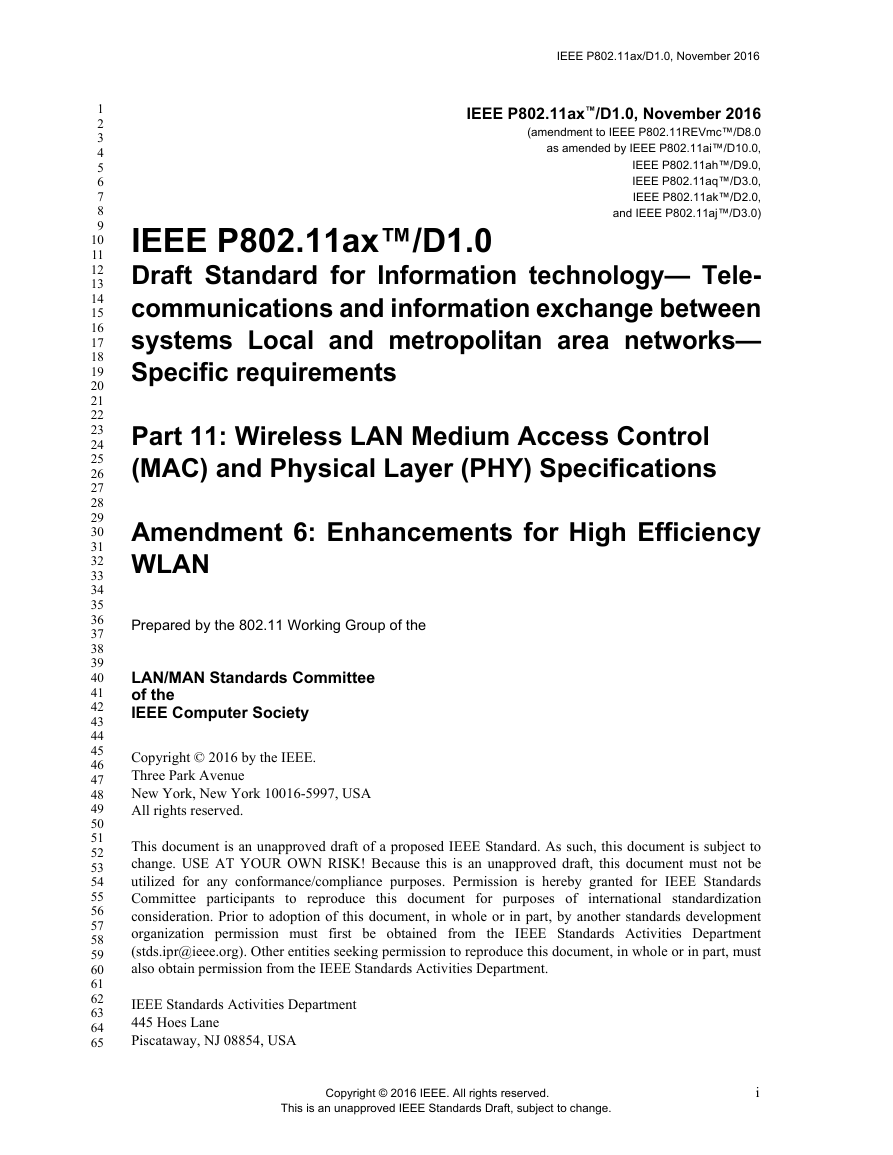
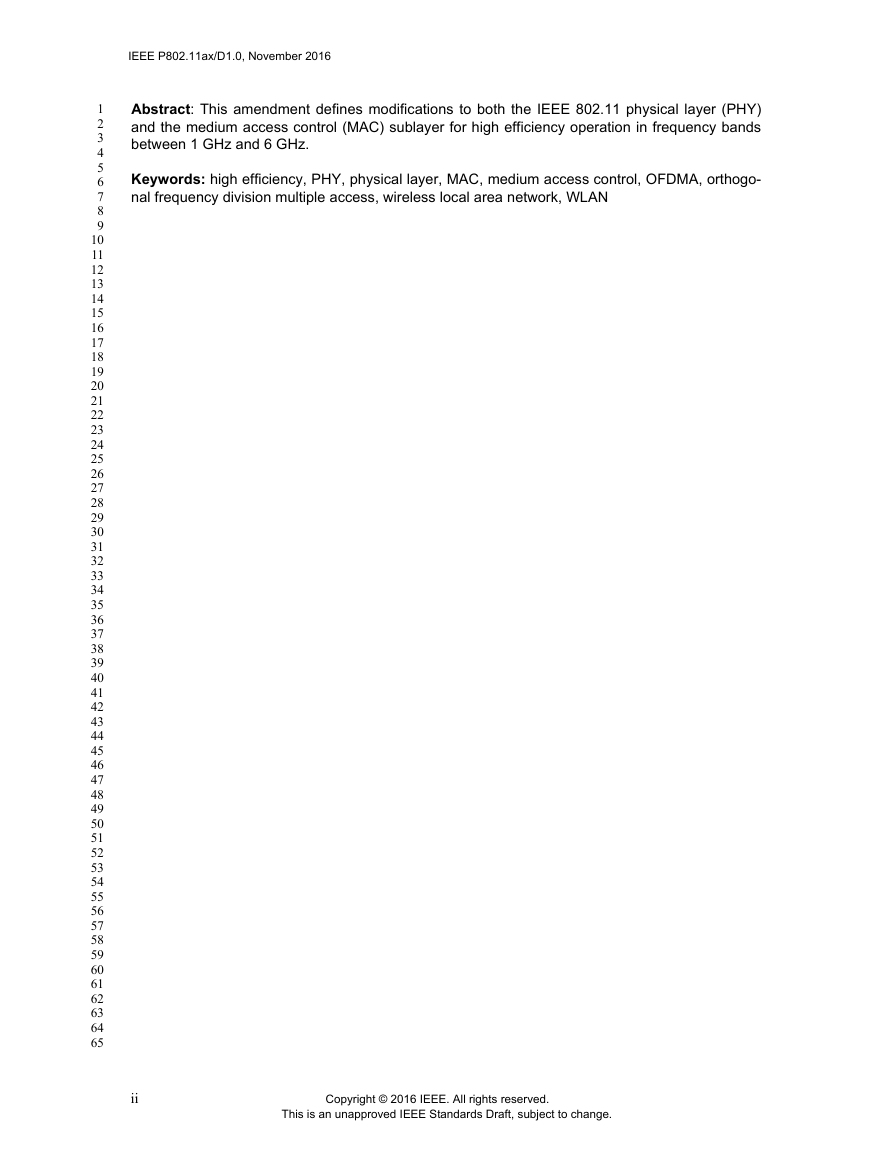
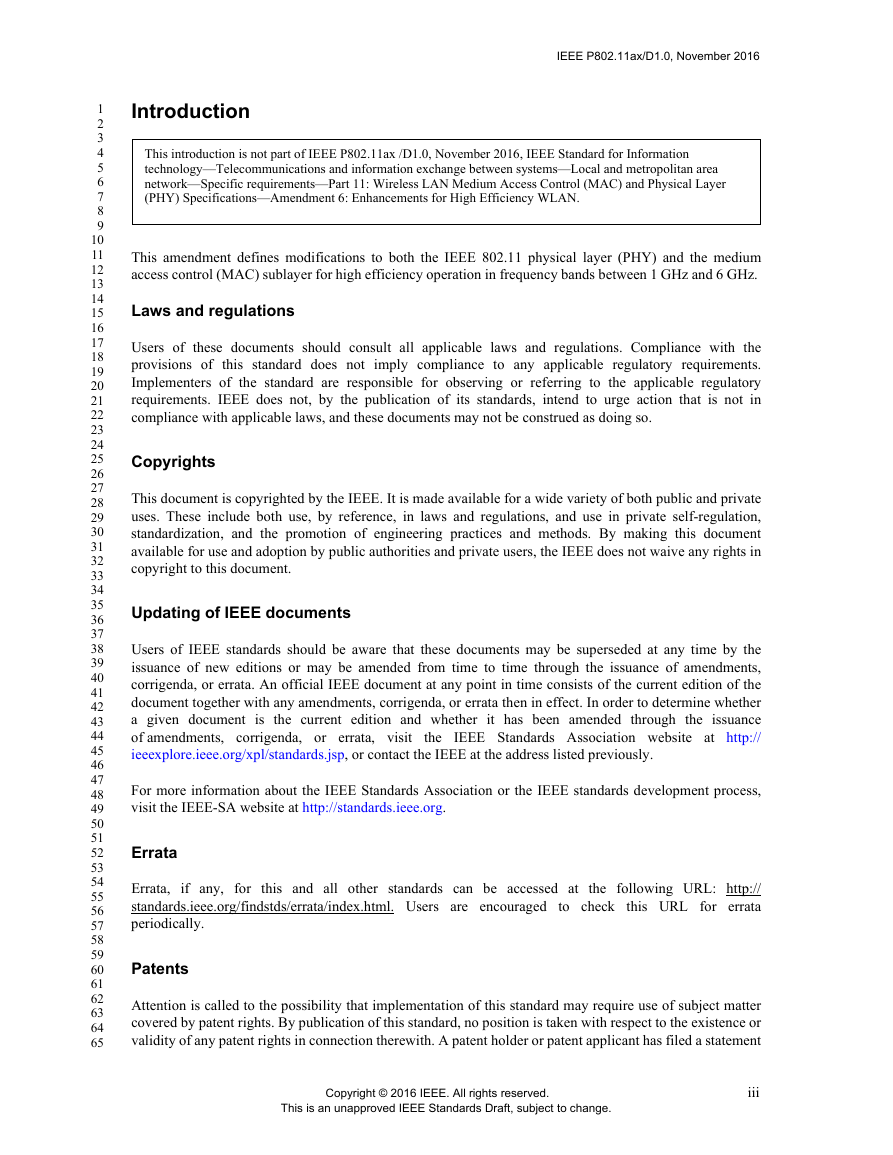
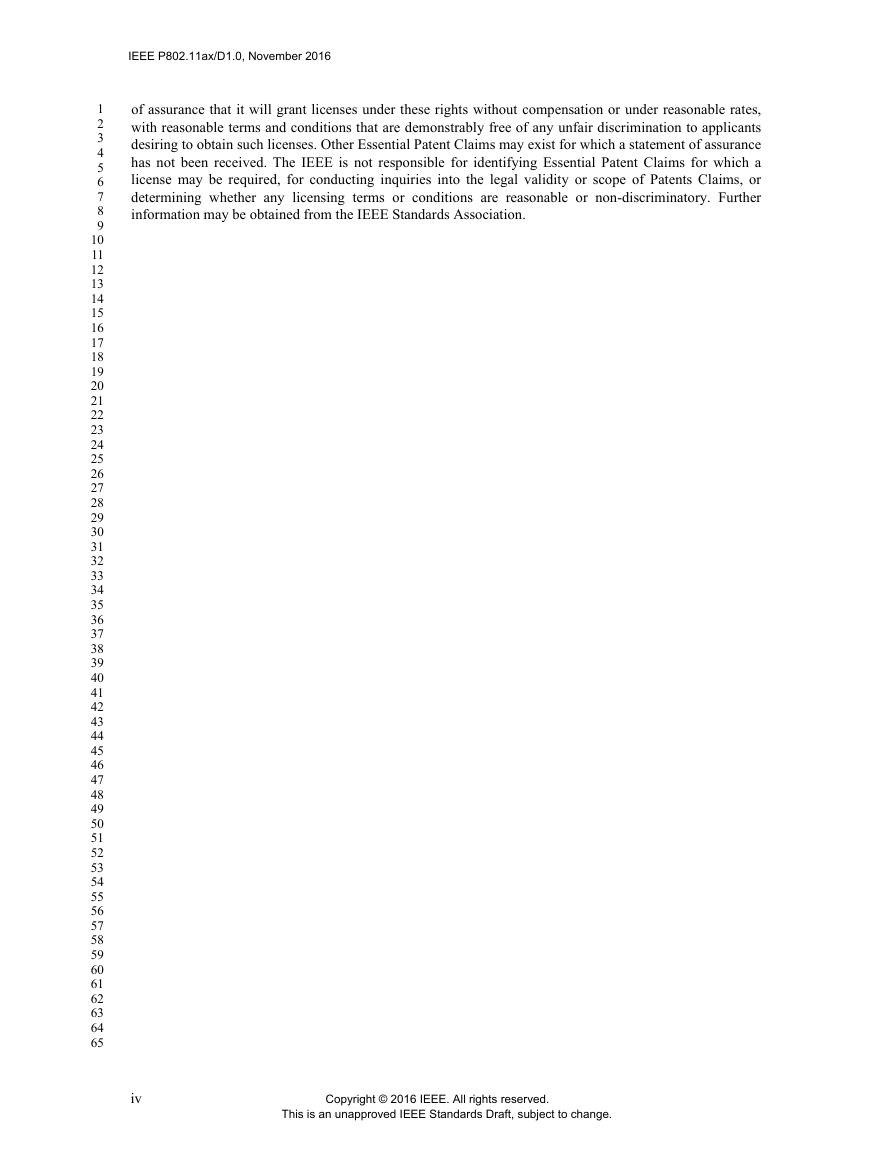
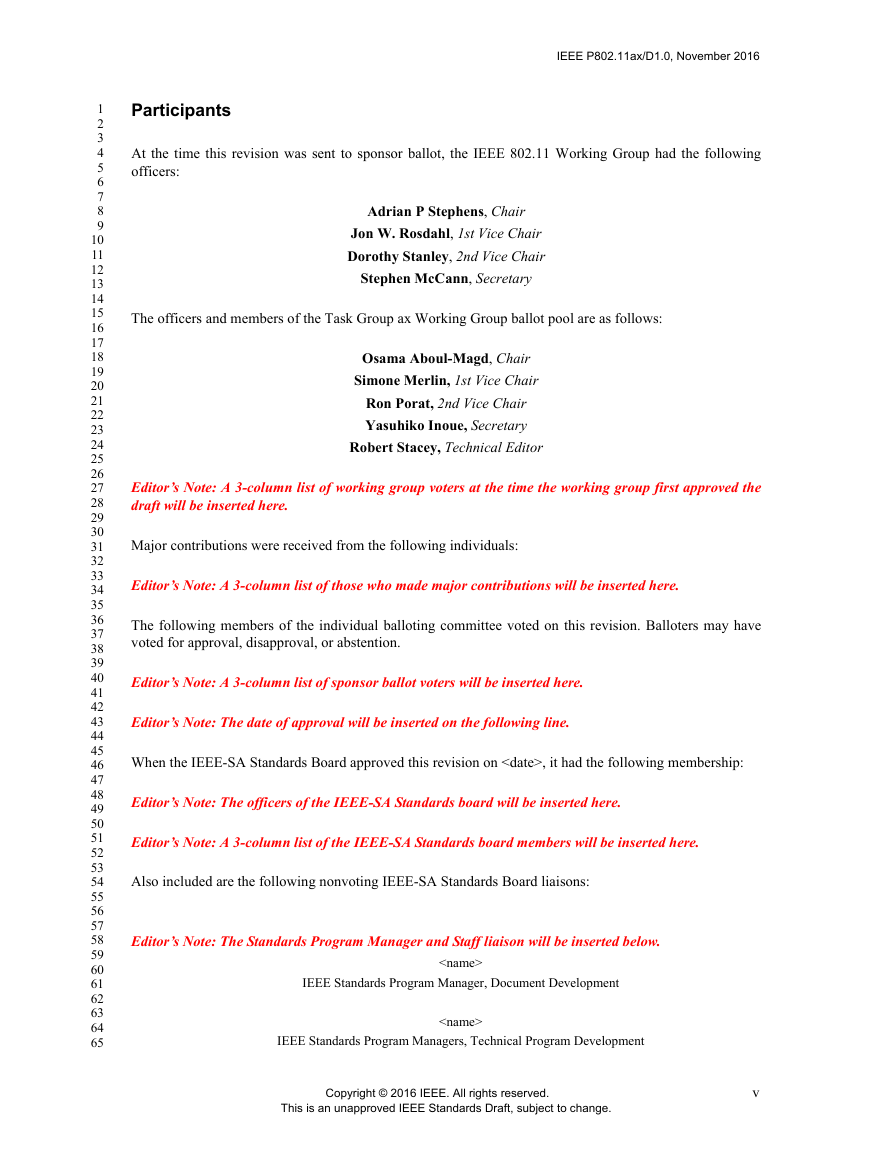
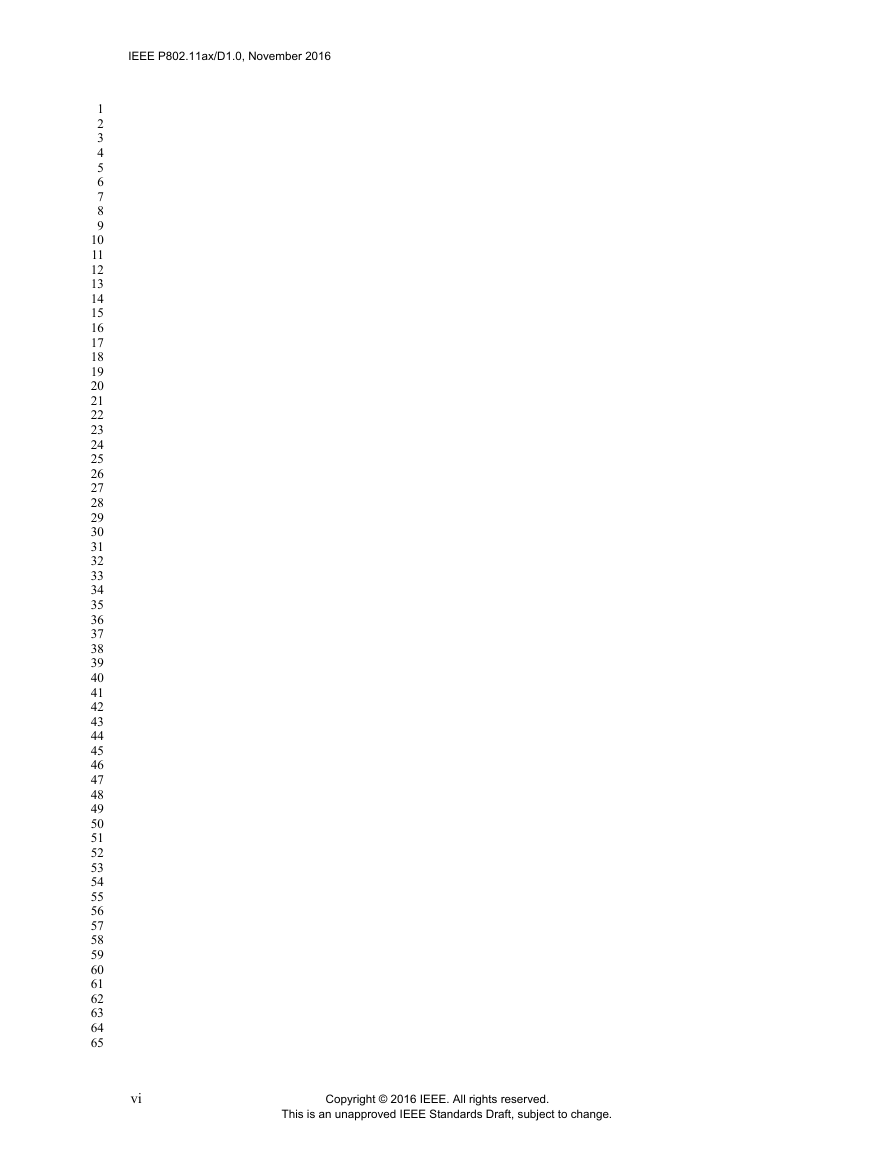
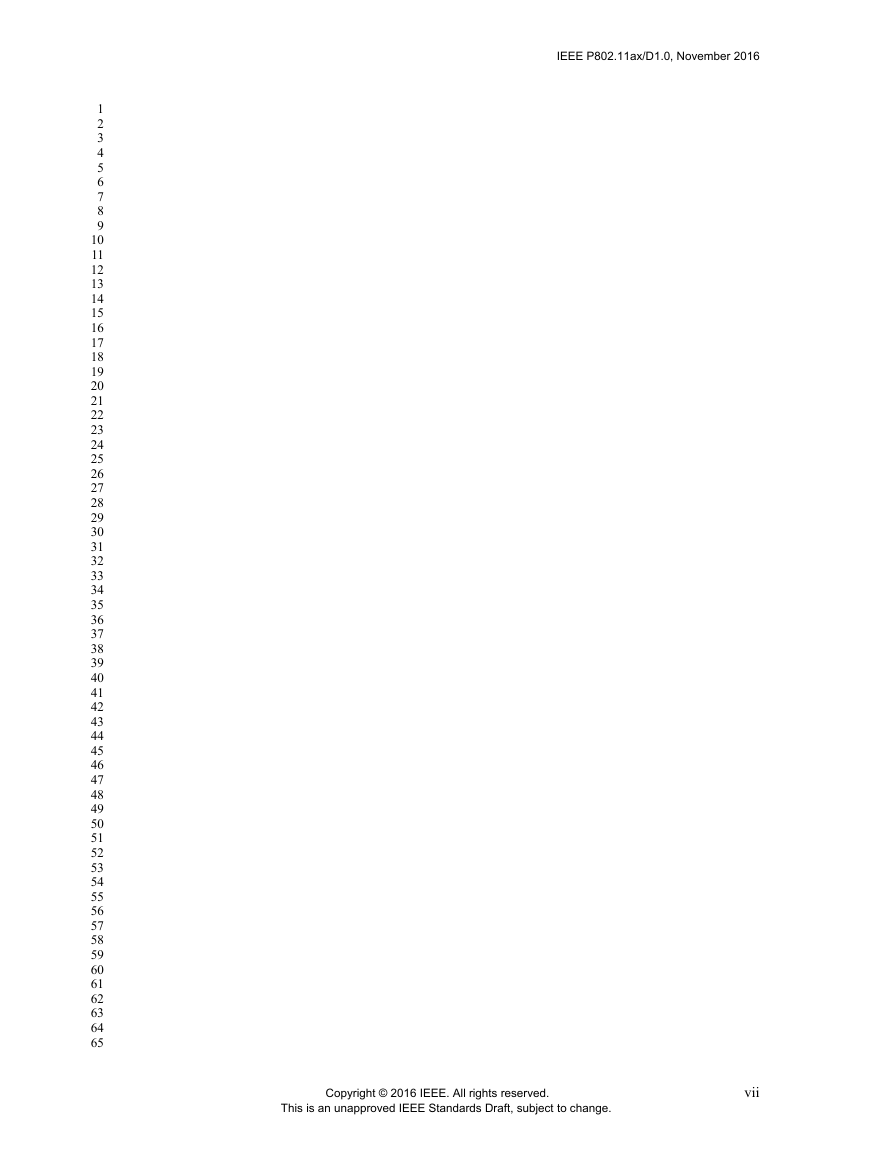









 2023年江西萍乡中考道德与法治真题及答案.doc
2023年江西萍乡中考道德与法治真题及答案.doc 2012年重庆南川中考生物真题及答案.doc
2012年重庆南川中考生物真题及答案.doc 2013年江西师范大学地理学综合及文艺理论基础考研真题.doc
2013年江西师范大学地理学综合及文艺理论基础考研真题.doc 2020年四川甘孜小升初语文真题及答案I卷.doc
2020年四川甘孜小升初语文真题及答案I卷.doc 2020年注册岩土工程师专业基础考试真题及答案.doc
2020年注册岩土工程师专业基础考试真题及答案.doc 2023-2024学年福建省厦门市九年级上学期数学月考试题及答案.doc
2023-2024学年福建省厦门市九年级上学期数学月考试题及答案.doc 2021-2022学年辽宁省沈阳市大东区九年级上学期语文期末试题及答案.doc
2021-2022学年辽宁省沈阳市大东区九年级上学期语文期末试题及答案.doc 2022-2023学年北京东城区初三第一学期物理期末试卷及答案.doc
2022-2023学年北京东城区初三第一学期物理期末试卷及答案.doc 2018上半年江西教师资格初中地理学科知识与教学能力真题及答案.doc
2018上半年江西教师资格初中地理学科知识与教学能力真题及答案.doc 2012年河北国家公务员申论考试真题及答案-省级.doc
2012年河北国家公务员申论考试真题及答案-省级.doc 2020-2021学年江苏省扬州市江都区邵樊片九年级上学期数学第一次质量检测试题及答案.doc
2020-2021学年江苏省扬州市江都区邵樊片九年级上学期数学第一次质量检测试题及答案.doc 2022下半年黑龙江教师资格证中学综合素质真题及答案.doc
2022下半年黑龙江教师资格证中学综合素质真题及答案.doc